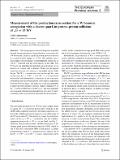Measurement of the production cross section for a W boson in association with a charm quark in proton–proton collisions at √s = 13 TeV
Author(s)
Unknown author
Download10052_2023_Article_12258.pdf (2.476Mb)
Publisher with Creative Commons License
Publisher with Creative Commons License
Creative Commons Attribution
Terms of use
Metadata
Show full item recordAbstract
The strange quark content of the proton is probed through the measurement of the production cross section for a W boson and a charm (c) quark in proton–proton collisions at a center-of-mass energy of 13
$$\,\text {Te}\hspace{-.08em}\text {V}$$
Te
V
. The analysis uses a data sample corresponding to a total integrated luminosity of 138
$$\,\text {fb}^{-1}$$
fb
-
1
collected with the CMS detector at the LHC. The W bosons are identified through their leptonic decays to an electron or a muon, and a neutrino. Charm jets are tagged using the presence of a muon or a secondary vertex inside the jet. The
$$\hbox {W}+\hbox {c}$$
W
+
c
production cross section and the cross section ratio
$$R_\textrm{c}^{\pm }= \sigma ({\hbox {W}}^{+}+\bar{\text {c}})/\sigma (\hbox {W}^{-}+{\textrm{c}})$$
R
c
±
=
σ
(
W
+
+
c
¯
)
/
σ
(
W
-
+
c
)
are measured inclusively and differentially as functions of the transverse momentum and the pseudorapidity of the lepton originating from the W boson decay. The precision of the measurements is improved with respect to previous studies, reaching 1% in
$$R_\textrm{c}^{\pm }= 0.950 \pm 0.005\,\text {(stat)} \pm 0.010 \,\text {(syst)} $$
R
c
±
=
0.950
±
0.005
(stat)
±
0.010
(syst)
. The measurements are compared with theoretical predictions up to next-to-next-to-leading order in perturbative quantum chromodynamics.
Date issued
2024-01-10Department
Massachusetts Institute of Technology. Department of PhysicsPublisher
Springer Berlin Heidelberg
Citation
The European Physical Journal C. 2024 Jan 10;84(1):27
Version: Final published version